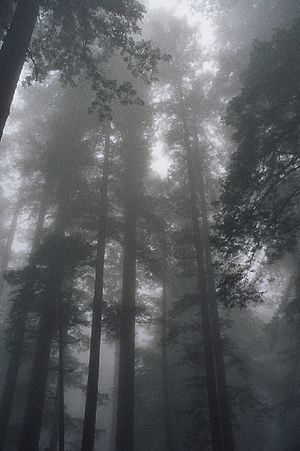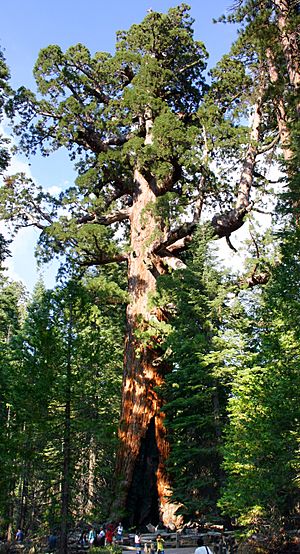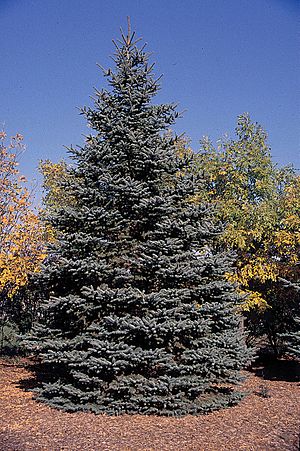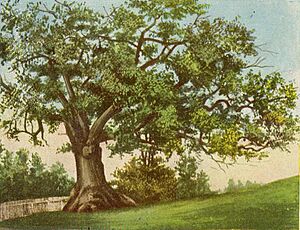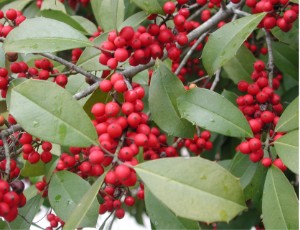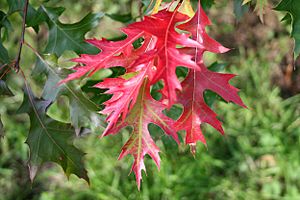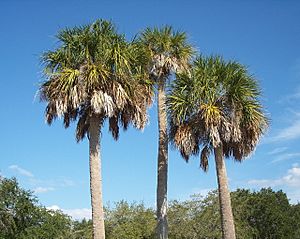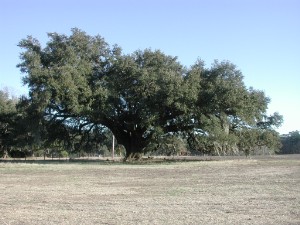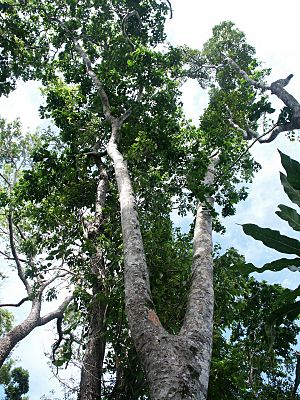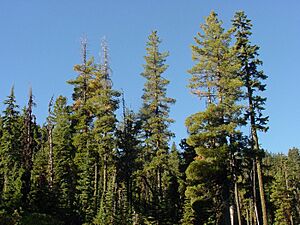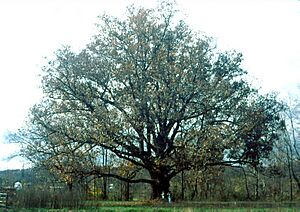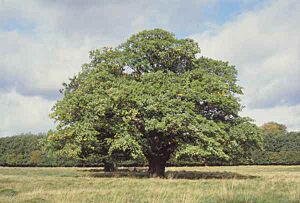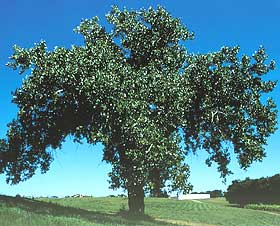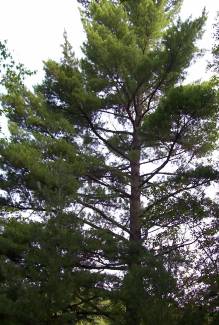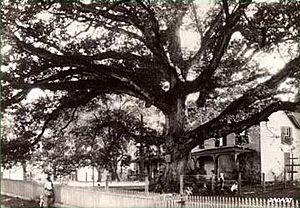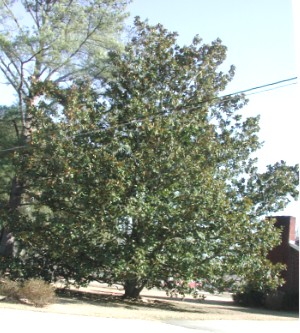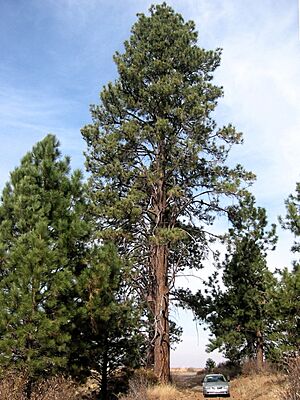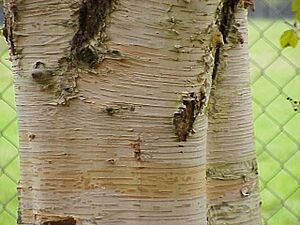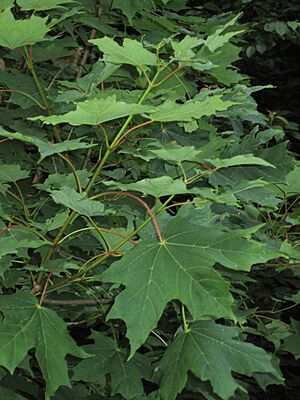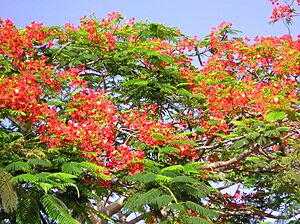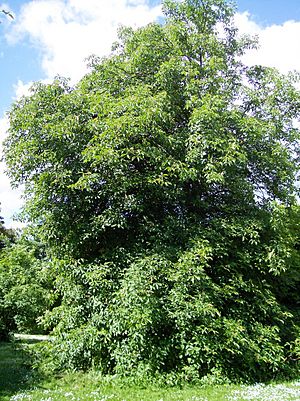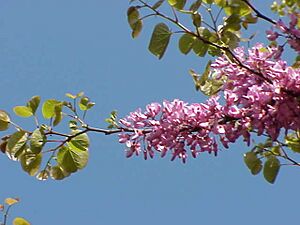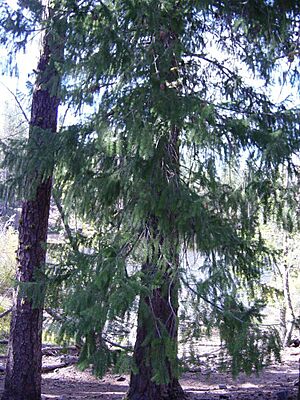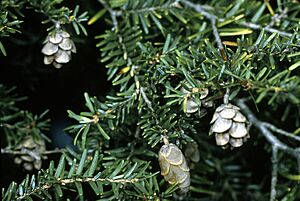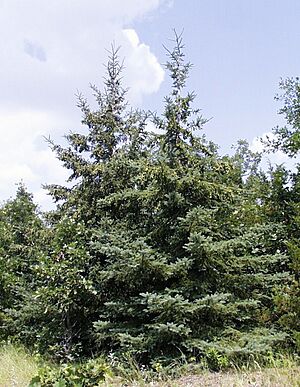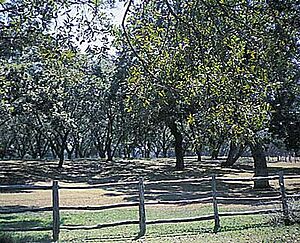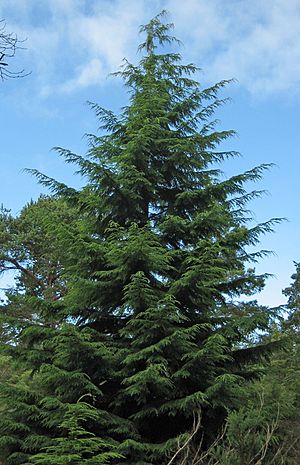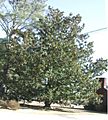List of U.S. state and territory trees facts for kids
Many places in the United States, including states, the federal district, and territories, have chosen special trees to represent them. These official trees are symbols of the natural beauty and history of each area. They are often picked because they are common there, have a special meaning, or are important to the environment.
This list shows the official trees for each U.S. state, the federal district of Washington, D.C., and the U.S. territories. Each tree has a common name you might know and a scientific name, which is a unique name used by scientists all over the world.
Contents
- Official State and Territory Trees
- Alabama's Longleaf Pine
- Alaska's Sitka Spruce
- Arizona's Blue Palo Verde
- Arkansas's Loblolly Pine
- California's Redwood Giants
- Colorado's Blue Spruce
- Connecticut's White Oak
- Delaware's American Holly
- District of Columbia's Scarlet Oak
- Florida's Sabal Palm
- Georgia's Southern Live Oak
- Guam's Ifit Tree
- Hawaii's Candlenut Tree
- Idaho's Western White Pine
- Illinois's White Oak
- Indiana's Tulip Tree
- Iowa's Oak
- Kansas's Eastern Cottonwood
- Kentucky's Tulip-tree
- Louisiana's Bald Cypress
- Maine's Eastern White Pine
- Maryland's White Oak
- Massachusetts's American Elm
- Michigan's Eastern White Pine
- Minnesota's Red Pine
- Mississippi's Southern Magnolia
- Missouri's Flowering Dogwood
- Montana's Ponderosa Pine
- Nebraska's Eastern Cottonwood
- Nevada's Desert Pines
- New Hampshire's American White Birch
- New Jersey's Northern Red Oak
- New Mexico's Piñon Pine
- New York's Sugar Maple
- North Carolina's Pine
- North Dakota's American Elm
- Northern Mariana Islands' Flame Tree
- Ohio's Ohio Buckeye
- Oklahoma's Eastern Redbud
- Oregon's Douglas Fir
- Pennsylvania's Eastern Hemlock
- Puerto Rico's Ceiba
- Rhode Island's Red Maple
- South Carolina's Sabal Palm
- South Dakota's Black Hills Spruce
- Tennessee's Tulip-tree
- Texas's Pecan
- Utah's Quaking Aspen
- Vermont's Sugar Maple
- Virginia's Flowering Dogwood
- Washington's Western Hemlock
- West Virginia's Sugar Maple
- Wisconsin's Sugar Maple
- Wyoming's Plains Cottonwood
- Territories Without Official Trees
- Images for kids
- See also
Official State and Territory Trees
Alabama's Longleaf Pine
Alabama's official tree is the Longleaf pine (Pinus palustris). It became official in 1949 and was clarified in 1997. This pine is known for its very long needles and strong wood.
Alaska's Sitka Spruce
Alaska chose the Sitka spruce (Picea sitchensis) as its state tree in 1962. This giant tree is the largest spruce species and grows along the Pacific coast.
Arizona's Blue Palo Verde
In 1954, Arizona picked the Blue palo verde (Parkinsonia florida). This desert tree has a unique blue-green bark and bright yellow flowers.
Arkansas's Loblolly Pine
The Loblolly pine (Pinus taeda) became Arkansas's state tree in 1939. It's a fast-growing pine that's very common in the southeastern U.S.
California's Redwood Giants
California has two official state trees, both chosen in 1937. They are the Coast redwood (Sequoia sempervirens) and the Giant sequoia (Sequoiadendron giganteum). These are some of the tallest and most massive trees on Earth!
Colorado's Blue Spruce
The Colorado blue spruce (Picea pungens) was named Colorado's state tree in 1939. It's famous for its beautiful blue-green needles.
Connecticut's White Oak
Connecticut's state tree is the White oak (Quercus alba), chosen in 1947. A famous White Oak, the Charter Oak, played a role in Connecticut's history.
Delaware's American Holly
The American holly (Ilex opaca) became Delaware's state tree in 1939. It's known for its shiny green leaves and bright red berries, especially around winter.
District of Columbia's Scarlet Oak
Washington, D.C., chose the Scarlet oak (Quercus coccinea) in 1960. This tree is loved for its brilliant red leaves in the fall.
Florida's Sabal Palm
Florida's official tree is the Sabal palm (Sabal palmetto), adopted in 1953. This sturdy palm tree is a symbol of the state's warm climate.
Georgia's Southern Live Oak
In 1937, Georgia picked the Southern live oak (Quercus virginiana). These trees are famous for their wide, spreading branches and long lifespan.
Guam's Ifit Tree
Guam's official tree is the Ifit (Intsia bijuga), also called Pacific teak, chosen in 1969. It's a strong, beautiful tree found in tropical areas.
Hawaii's Candlenut Tree
Hawaii's state tree is the Candlenut tree (Aleurites moluccanus), known locally as kukui. It became official in 1959. Its nuts were traditionally used for light.
Idaho's Western White Pine
The Western white pine (Pinus monticola) was chosen as Idaho's state tree in 1935. It's a tall, slender pine found in the western mountains.
Illinois's White Oak
Illinois also chose the White oak (Quercus alba) as its state tree in 1973, showing its importance across different states.
Indiana's Tulip Tree
Indiana's state tree is the Tulip tree (Liriodendron tulipifera), adopted in 1931. It gets its name from its unique, tulip-shaped flowers.
Iowa's Oak
Iowa's official tree is simply the Oak (Quercus spp.), chosen in 1961. This means any type of oak tree can represent the state.
Kansas's Eastern Cottonwood
The Eastern cottonwood (Populus deltoides) became Kansas's state tree in 1937. It's a fast-growing tree often found near rivers.
Kentucky's Tulip-tree
Kentucky also chose the Tulip-tree (Liriodendron tulipifera) as its state tree. It's a popular choice for its beauty.
Louisiana's Bald Cypress
In 1963, Louisiana named the Bald cypress (Taxodium distichum) its state tree. These trees are unique because they can grow in swamps and lose their needles in winter.
Maine's Eastern White Pine
Maine's state tree is the Eastern white pine (Pinus strobus), adopted in 1945. It's a very tall and important tree in the state's history.
Maryland's White Oak
Maryland also chose the White oak (Quercus alba) in 1941. The famous Wye Oak was a beloved symbol of the state for centuries.
Massachusetts's American Elm
The American elm (Ulmus americana) became Massachusetts's state tree in 1941. It's known for its graceful, vase-like shape.
Michigan's Eastern White Pine
Michigan also chose the Eastern white pine (Pinus strobus) as its state tree in 1955, highlighting its importance in the Great Lakes region.
Minnesota's Red Pine
In 1953, Minnesota picked the Red pine (Pinus resinosa), also called Norway pine. It's known for its reddish bark and long needles.
Mississippi's Southern Magnolia
Mississippi's state tree is the Southern magnolia (Magnolia grandiflora), adopted in 1952. It's famous for its large, fragrant white flowers.
Missouri's Flowering Dogwood
The Flowering dogwood (Cornus florida) became Missouri's state tree in 1955. It's loved for its beautiful white or pink flowers in spring.
Montana's Ponderosa Pine
Montana chose the Ponderosa pine (Pinus ponderosa) in 1949. This large pine is common in the western U.S. and has a unique scent.
Nebraska's Eastern Cottonwood
Nebraska also selected the Eastern cottonwood (Populus deltoides) as its state tree in 1972, showing its widespread presence.
Nevada's Desert Pines
Nevada has two state trees. The Single-leaf pinyon (Pinus monophylla) was chosen in 1959, and the Great Basin bristlecone pine (Pinus longaeva) was added in 1987. Bristlecone pines are some of the oldest living things on Earth!
New Hampshire's American White Birch
New Hampshire's state tree is the American white birch (Betula papyrifera), adopted in 1947. It's known for its beautiful peeling white bark.
New Jersey's Northern Red Oak
In 1950, New Jersey picked the Northern red oak (Quercus rubra). This oak is valued for its strong wood and beautiful fall colors.
New Mexico's Piñon Pine
New Mexico chose the Piñon pine (Pinus edulis) in 1949. This small pine produces edible pine nuts.
New York's Sugar Maple
New York's state tree is the Sugar maple (Acer saccharum), adopted in 1956. It's famous for its sweet sap, which is used to make maple syrup, and its bright fall foliage.
North Carolina's Pine
North Carolina's official tree is simply the Pine (Pinus), chosen in 1963. This recognizes the importance of various pine species to the state.
North Dakota's American Elm
North Dakota also chose the American elm (Ulmus americana) as its state tree in 1947.
Northern Mariana Islands' Flame Tree
The Northern Mariana Islands' official tree is the Flame tree (Delonix regia), adopted in 1979. It's known for its stunning bright red-orange flowers.
Ohio's Ohio Buckeye
Ohio's state tree is the Ohio buckeye (Aesculus glabra), chosen in 1953. Its nuts resemble a deer's eye, giving it its name.
Oklahoma's Eastern Redbud
In 1971, Oklahoma picked the Eastern redbud (Cercis canadensis). This tree is famous for its beautiful pink-purple flowers that bloom in early spring.
Oregon's Douglas Fir
Oregon's state tree is the Douglas fir (Pseudotsuga menziesii), adopted in 1939. It's one of the most important timber trees in North America.
Pennsylvania's Eastern Hemlock
Pennsylvania chose the Eastern hemlock (Tsuga canadensis) in 1931. This evergreen tree is known for its delicate needles and graceful branches.
Puerto Rico's Ceiba
Puerto Rico has an unofficial tree, the Ceiba (Ceiba pentandra). These are very large and impressive trees found in tropical regions.
Rhode Island's Red Maple
Rhode Island's state tree is the Red maple (Acer rubrum), adopted in 1964. It's named for its reddish twigs, buds, and beautiful red fall leaves.
South Carolina's Sabal Palm
South Carolina also chose the Sabal palm (Sabal palmetto) as its state tree in 1939, sharing this symbol with Florida.
South Dakota's Black Hills Spruce
In 1947, South Dakota picked the Black Hills spruce (Picea glauca var. densata). This special type of spruce is native to the Black Hills region.
Tennessee's Tulip-tree
Tennessee also chose the Tulip-tree (Liriodendron tulipifera) as its state tree in 1947.
Texas's Pecan
Texas's state tree is the Pecan (Carya illinoinensis), adopted in 1919. It's famous for producing delicious pecan nuts.
Utah's Quaking Aspen
In 2014, Utah chose the Quaking aspen (Populus tremuloides). These trees are known for their leaves that "quake" or tremble in the slightest breeze.
Vermont's Sugar Maple
Vermont also chose the Sugar maple (Acer saccharum) as its state tree in 1949, recognizing its importance for maple syrup production.
Virginia's Flowering Dogwood
Virginia's state tree is the Flowering dogwood (Cornus florida), adopted in 1956.
Washington's Western Hemlock
In 1947, Washington chose the Western hemlock (Tsuga heterophylla). It's a large evergreen tree important to the state's forests.
West Virginia's Sugar Maple
West Virginia also chose the Sugar maple (Acer saccharum) as its state tree in 1949.
Wisconsin's Sugar Maple
Wisconsin also chose the Sugar maple (Acer saccharum) as its state tree in 1949.
Wyoming's Plains Cottonwood
Wyoming's state tree is the Plains cottonwood (Populus deltoides monilifera), chosen in 1947 and amended in 1961. It's a tough tree that thrives in the plains.
Territories Without Official Trees
- American Samoa does not have an official tree.
- The United States Virgin Islands also do not have an official tree.
Images for kids
See also
- List of U.S. state, district, and territorial insignia
- National Grove of State Trees
- National Register of Champion Trees






